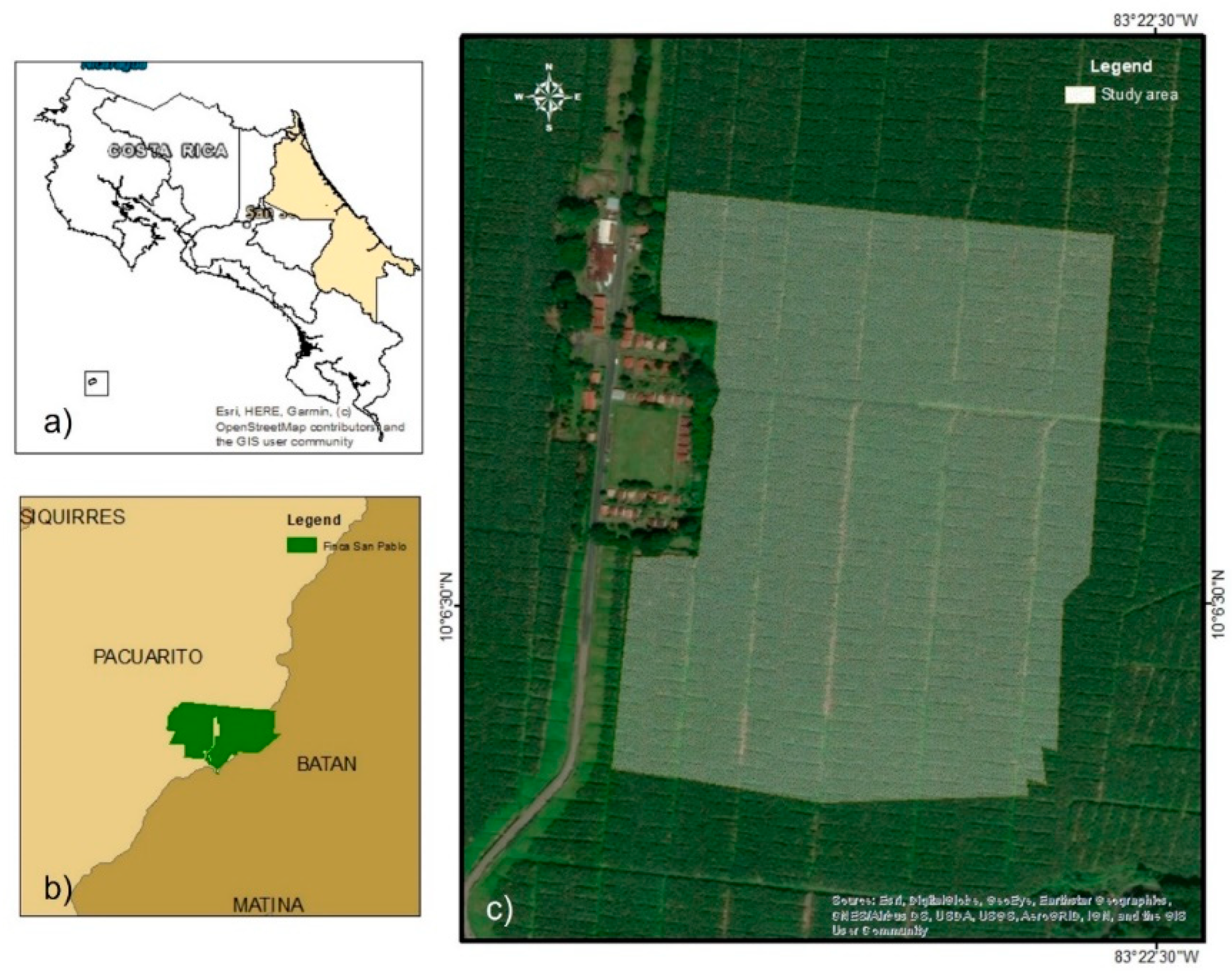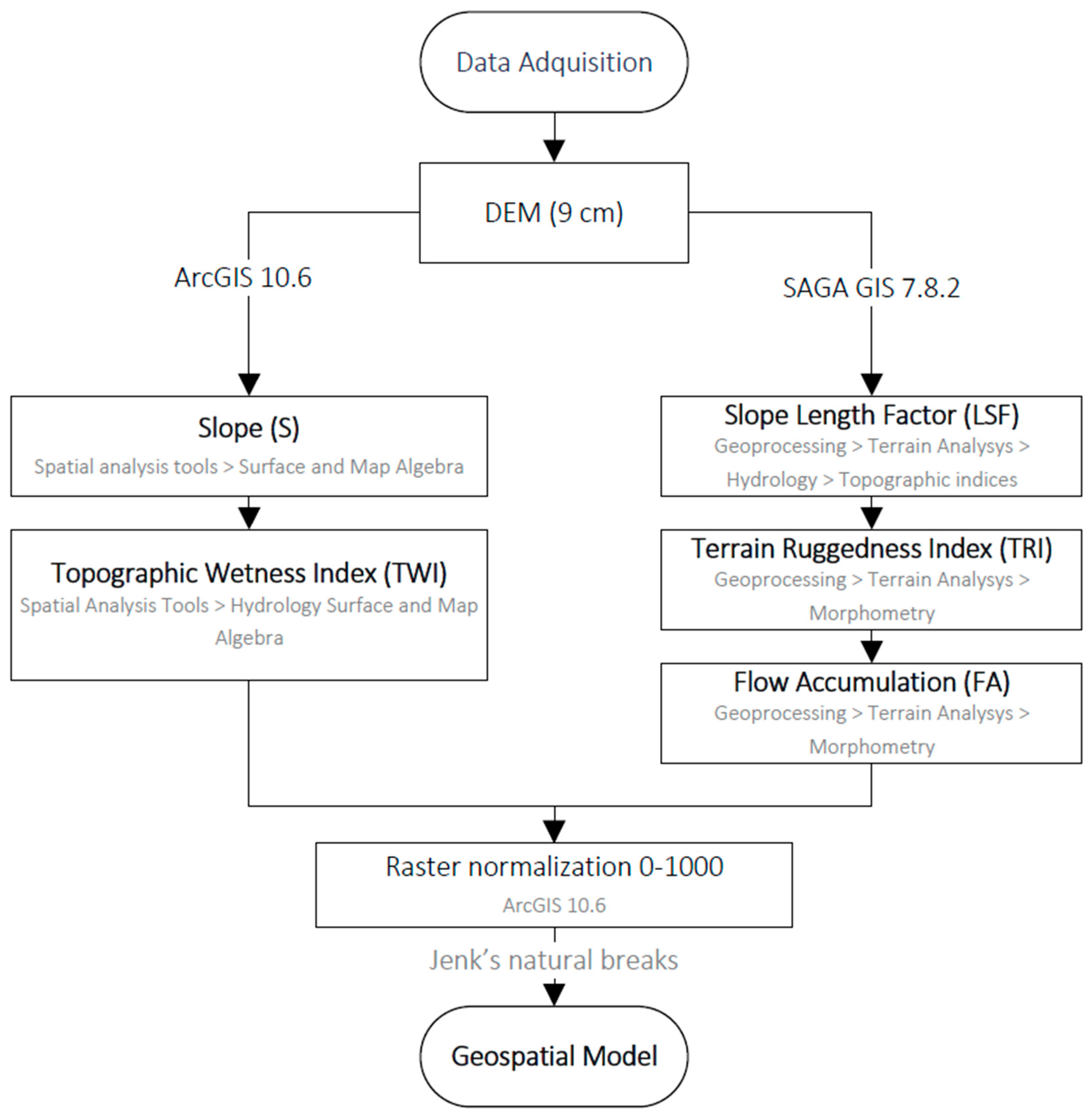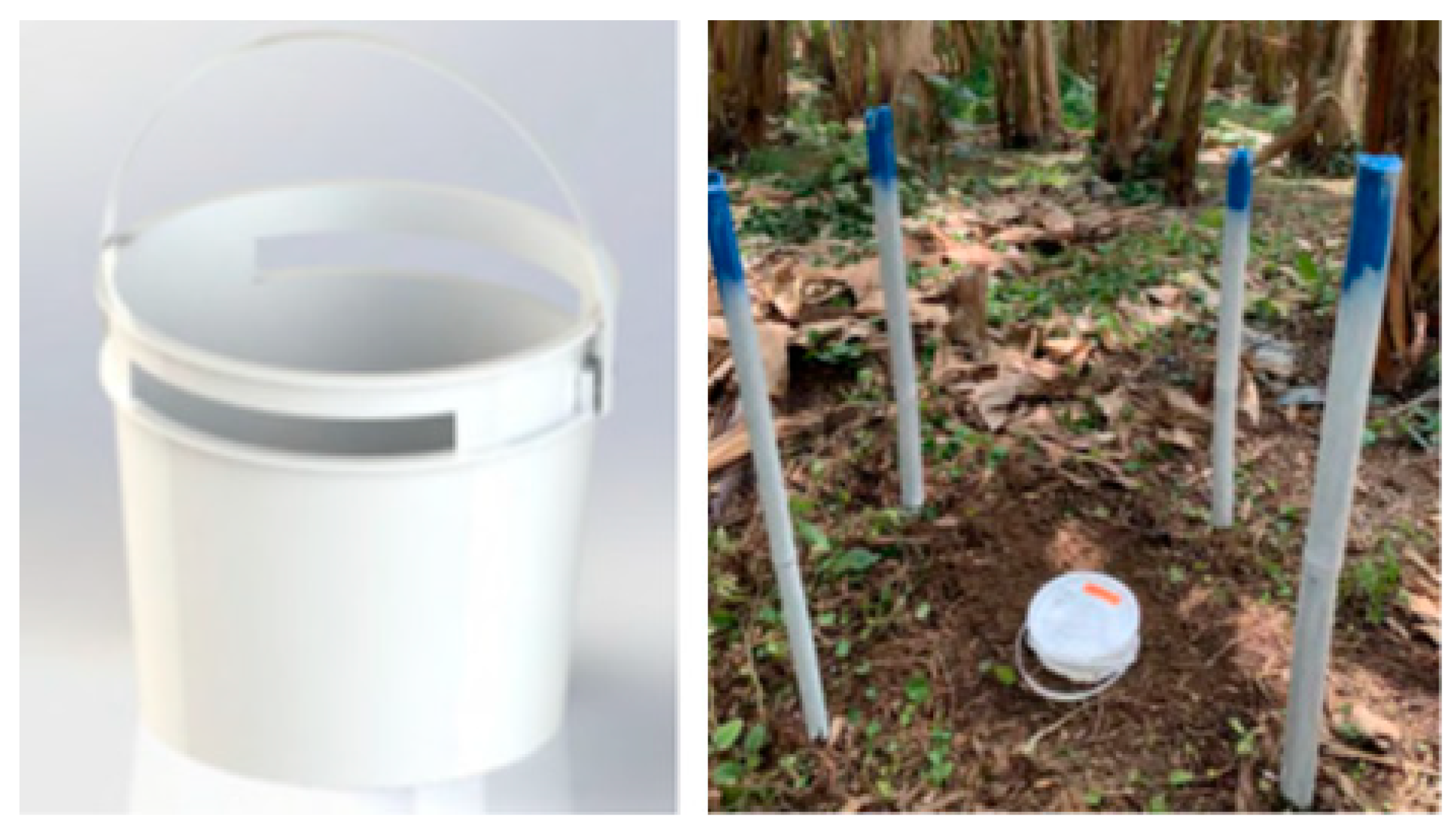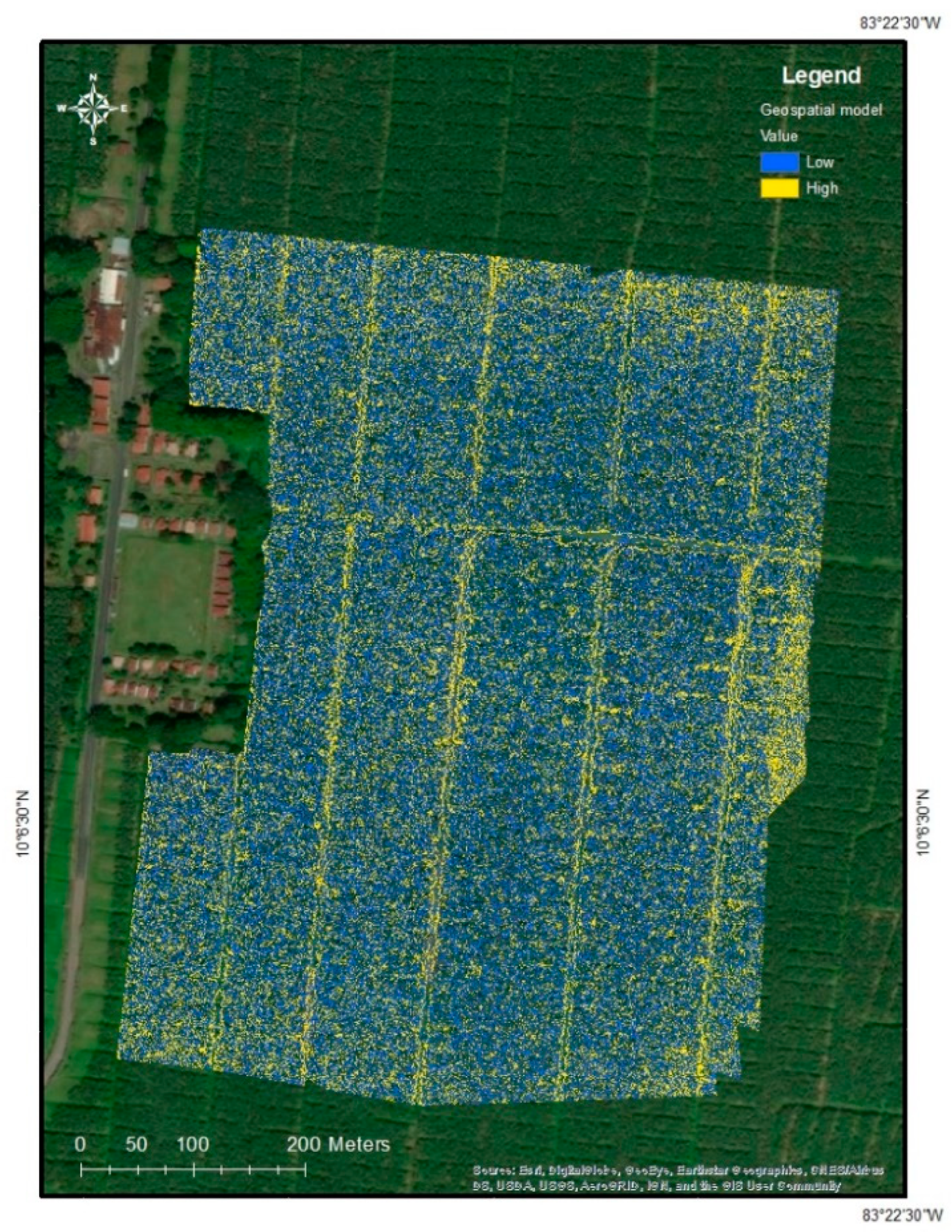Geospatial Approach to Determine Nitrate Values in Banana Plantations
Abstract
:1. Introduction
2. Material and Methods
2.1. Study Area
2.2. Geospatial Model
2.3. Sampling
2.4. Sample Analysis
2.5. Statistical Analysis
2.6. Generalized Linear Model
3. Results
3.1. Geospatial Model
3.2. Nitrate Ion Concentration
3.3. Generalized Linear Model
4. Discussion
4.1. Geospatial Model Implications in Agriculture
4.2. Factors Controlling Chemical Substance Concentrations in Banana Fields
4.3. Geospatial Model Application in Other Croplands
5. Conclusions
Author Contributions
Funding
Data Availability Statement
Acknowledgments
Conflicts of Interest
References
- Kumar, P.L.; Selvarajan, R.; Iskra-Caruana, M.L.; Chabannes, M.; Hanna, R. Biology, etiology, and control of virus diseases of banana and plantain. In Advances in Virus Research; Elsevier Inc.: Amsterdam, The Netherlands, 2015; Volume 91, pp. 1–240. [Google Scholar]
- Evans, E.A.; Ballen, F.H.; Siddiq, M. Banana production, global trade, consumption trends, postharvest handling, and processing. In Handbook of Banana Production, Postharvest Science, Processing Technology, and Nutrition; Siddiq, M., Ed.; John Wiley & Sons, Inc.: Hoboken, NJ, USA, 2020; pp. 1–18. [Google Scholar]
- Audesirk, G.; Audesirk, T.; Byers, B.E. Biology: Life on Earth with Physiology, 9th ed.; Pearson: Boston, MA, USA, 2011. [Google Scholar]
- Udvardi, M.; Below, F.E.; Castellano, M.J.; Eagle, A.J.; Giller, K.E.; Ladha, J.K.; Liu, X.; Maaz, T.M.; Nova-Franco, B.; Raghuram, N.; et al. A Research Road Map for Responsible Use of Agricultural Nitrogen. Front. Sustain. Food Syst. 2021, 5, 660155. [Google Scholar] [CrossRef]
- Wang, Z.-H.; Li, S.-X. Nitrate N loss by leaching and surface runoff in agricultural land: A global issue (a review). Adv. Agron. 2019, 156, 159–217. [Google Scholar]
- Zhao, J.; Pullens, J.W.M.; Sørensen, P.; Blicher-Mathiesen, G.; Olesen, J.E.; Børgesen, C.D. Agronomic and environmental factors influencing the marginal increase in nitrate leaching by adding extra mineral nitrogen fertilizer. Agric. Ecosyst. Environ. 2022, 327, 107808. [Google Scholar] [CrossRef]
- Sun, R.; Ding, J.; Li, H.; Wang, X.; Li, W.; Li, K.; Ye, L.; Sun, S. Mitigating nitrate leaching in cropland by enhancing microbial nitrate transformation through the addition of liquid biogas slurry. Agric. Ecosyst. Environ. 2023, 345, 108324. [Google Scholar] [CrossRef]
- Di, H.J.; Cameron, K.C. Nitrate leaching in temperate agroecosystems: Sources, factors and mitigating strategies. Nutr. Cycl. Agroecosyst. 2002, 64, 237–256. [Google Scholar] [CrossRef]
- Brase, T. Basics of a geographic information system. In Precision Agriculture Basics; John Wiley & Sons, Inc.: Hoboken, NJ, USA, 2018; pp. 37–62. [Google Scholar]
- Guzmán-Álvarez, J.A.; González-Zuñiga, M.; Fernandez, J.A.S.; Calvo-Alvarado, J.C. Use of remote sensing in agriculture: Applications in banana crop. Agron. Mesoam. 2022, 33, 139–154. [Google Scholar]
- Vélez Duque, P. Optimization of banana crop fertilization using GIS tools. Centrosur Agrar. 2022, 15, 1–13. [Google Scholar]
- Meya, A.I.; Ndakidemi, P.A.; Mtei, K.M.; Swennen, R.; Merckx, R. Optimizing soil fertility management strategies to enhance banana production in volcanic soils of the Northern Highlands, Tanzania. Agronomy 2020, 10, 258. [Google Scholar] [CrossRef]
- Borole, V.Y.; Kulkarni, S.B. Comparative Analysis of Soil Properties for Influence of Fertilizers using Remote Sensing Techniques. Int. J. Comput. Appl. 2017, 975, 8887. [Google Scholar] [CrossRef]
- Aeberli, A.; Johansen, K.; Robson, A.; Lamb, D.W.; Phinn, S. Detection of Banana Plants Using Multi-Temporal Multispectral UAV Imagery. Remote Sens. 2021, 13, 2517. [Google Scholar] [CrossRef]
- Gomez Selvaraj, M.; Vergara, A.; Montenegro, F.; Ruiz, H.A.; Safari, N.; Raymaekers, D.; Ocimatie, W.; Ntamwirac, J.; Titsd, L.; Blomme, G.; et al. Detection of banana plants and their major diseases through aerial images and machine learning methods: A case study in DR Congo and Republic of Benin. ISPRS J. Photogramm. Remote Sens. 2020, 169, 110–124. [Google Scholar] [CrossRef]
- Boitt, M.K. Hyperspectral Remote Sensing for Cropland Assessment and Modeling for Agro-Ecological Zones: A Case Study of Taita Hills, Kenya. Ph.D. Thesis, University of Twente, Enschede, The Netherlands, 2016. [Google Scholar]
- Ochola, D.; Boekelo, B.; van de Ven, G.W.; Taulya, G.; Kubiriba, J.; van Asten, P.J.; Giller, K.E. Mapping spatial distribution and geographic shifts of East African highland banana (Musa spp.) in Uganda. PLoS ONE 2022, 17, e0262752. [Google Scholar] [CrossRef] [PubMed]
- Quinta-Nova, L.; Ferreira, D. Land suitability analysis for emerging fruit crops in central Portugal using gis. Agric. For. 2020, 66, 41–48. [Google Scholar] [CrossRef]
- Hassan, S.I.; Alam, M.M.; Zia, M.Y.; Rashid, M.; Illahi, U.; Su’ud, M.M. Rice Crop Counting Using Aerial Imagery and GIS for the Assessment of Soil Health to Increase Crop Yield. Sensors 2022, 22, 7885. [Google Scholar] [CrossRef] [PubMed]
- Singha, C.; Swain, K.C.; Swain, S.K. Best Crop Rotation Selection with GIS-AHP Technique Using Soil Nutrient Variability. Agriculture 2020, 10, 221. [Google Scholar] [CrossRef]
- Debesa, G.; Gebre, S.L.; Melese, A.; Regassa, A.; Teka, S. GIS and remote sensing-based physical land suitability analysis for major cereal crops in Dabo Hana district, South-West Ethiopia. Cogent Food Agric. 2020, 6, 1780102. [Google Scholar] [CrossRef]
- ESRI (Environmental Systems Research Institute). ArcGIS Desktop 10.6; Environmental Systems Research Institute: Redlands, CA, USA, 2018. [Google Scholar]
- Cole-Parmer. Oakton by Cole-Parmer® Combination Ion-Selective Electrode (ISE), Nitrate. Available online: https://www.coleparmer.com/i/oakton-by-cole-parmer-combination-ion-selective-electrode-ise-nitrate/2750422 (accessed on 29 May 2024).
- Thermo Fisher Scientific. Orion StarTM A329 pH/ISE/Conductivity/Dissolved Oxygen Portable Multiparameter Meter; Thermo Fisher Scientific: Waltham, MA, USA, 2021. [Google Scholar]
- Cole-Parmer. Oakton Ionic Strength Adjustor (ISA) Solution, 2M (NH4)2SO4. Available online: https://www.coleparmer.com/i/oakton-ionic-strength-adjustor-isa-solution-2m-nh4-2so4/2750423 (accessed on 29 May 2024).
- Rienzo, J.; Casanoves, F.; Balzarini, M.; Gonzalez, L.; Tablada, M.; Robledo, C. InfoStat; Grupo InfoStat, FCA, Universidad Nacional de Córdoba: Córdoba, Argentina, 2018. [Google Scholar]
- Kruskal, W.; Wallis, A. Use of ranks in one-criterion variance analysis. J. Am. Stat. Assoc. 1952, 47, 583–621. [Google Scholar] [CrossRef]
- Burnham, K.P.; Anderson, D.R. Multimodel Inference: Understanding AIC and BIC in Model Selection. Sociol. Methods Res. 2004, 33, 261–304. [Google Scholar] [CrossRef]
- Vinod, H.D. Generalized correlation and kernel causality with applications in development economics. Commun. Stat. Simul. Comput. 2017, 46, 4513–4534. [Google Scholar] [CrossRef]
- R Core Team. R: A Language and Environment for Statistical Computing; R Foundation for Statistical Computing: Vienna, Austria, 2013. [Google Scholar]
- Hafeez, M.A.; Singh, S.P.; Chauhan, A.; Khan, M.T.; Kumar, N.; Chauhan, A.; Soni, S.K. Implementation of drone technology for farm monitoring & pesticide spraying: A review. Inf. Process. Agric. 2023, 10, 192–203. [Google Scholar] [CrossRef]
- Chen, Z.; Ye, F.; Fu, W.; Ke, Y.; Hong, H. The influence of DEM spatial resolution on landslide susceptibility mapping in the Baxie River basin, NW China. Nat. Hazards 2020, 101, 853–877. [Google Scholar] [CrossRef]
- Dai, W.; Yang, X.; Na, J.; Li, J.; Brus, D.; Xiong, L.; Tang, G.; Huang, X. Effects of DEM resolution on the accuracy of gully maps in loess hilly areas. Catena 2019, 177, 114–125. [Google Scholar] [CrossRef]
- Kilwenge, A.; Adewopo, J.; Sun, Z.; Schut, M. UAV-based mapping of banana land area for village-level decision-support in Rwanda. Remote Sens. 2021, 13, 4985. [Google Scholar] [CrossRef]
- Aeberli, A.; Phinn, S.; Johansen, K.; Robson, A.; Lamb, D.W. Characterisation of Banana Plant Growth Using High-Spatiotemporal-Resolution Multispectral UAV Imagery. Remote Sens. 2023, 15, 679. [Google Scholar] [CrossRef]
- Wang, C.; Cheng, W. Geomorphic influences on land use/cover diversity and pattern. Catena 2023, 230, 107245. [Google Scholar] [CrossRef]
- Murillo, J.; Méndez-Estrada, V.H.; Brenes Prendas, S. Efecto de Geophila macropoda (Rubiaceae) como arvense de cobertura en la erosión hídrica en bananales de Guápiles, Limón, Costa Rica. UNED Res. J. 2016, 8, 217–223. [Google Scholar] [CrossRef]
- Li, X.; McCarty, G.W.; Karlen, D.L.; Cambardella, C.A. Topographic metric predictions of soil redistribution and organic carbon in Iowa cropland fields. Catena 2018, 160, 222–232. [Google Scholar] [CrossRef]
- Salvato, L.A.; Pittelkow, C.M.; O’Geen, A.T.; Linquist, B.A. A geospatial assessment of soil properties to identify the potential for crop rotation in rice systems. Agric. Ecosyst. Environ. 2024, 359, 108753. [Google Scholar] [CrossRef]
- Yu, J.; Wang, J.; Leblon, B. Evaluation of Soil Properties, Topographic Metrics, Plant Height, and Unmanned Aerial Vehicle Multispectral Imagery Using Machine Learning Methods to Estimate Canopy Nitrogen Weight in Corn. Remote Sens. 2021, 13, 3105. [Google Scholar] [CrossRef]
- Valverde, E. Efecto de Distintos Sistemas de Manejo de Coberturas Sobre la Salud del Suelo, en una Finca Bananera de Siquirres, Limón, Costa Rica. Master’s Thesis, Universidad de Costa Rica, San José, Costa Rica, 2021. [Google Scholar]
- Jia, Z.; Wang, J.; Li, B.; Li, Y.; Zhou, Y.; Tong, G.; Yan, D.; Zhou, S. An integrated methodology for improving heavy metal risk management in soil-rice system. J. Clean. Prod. 2020, 273, 122797. [Google Scholar] [CrossRef]
- Hasni, R.; Mohidin, H.; Khan, M.Y.M.A.; Narawi, A.; Banchit, A.; Tamrin, K.F.; Jack, R.; Jos, S.; Salam, N.D. Determining Suitable Spatial Resolution To Estimate Nitrogen Status in Md2 Pineapple Crop Cultivated on Mineral Soil. J. Theor. Appl. Inf. Technol. 2022, 100, 870–885. [Google Scholar]
- Li, X.; Zhou, L.; Zhang, C.; Li, D.; Wang, Z.; Sun, D.; Liao, C.; Zhang, Q. Spatial distribution and risk assessment of fluorine and cadmium in rice, corn, and wheat grains in most karst regions of Guizhou province, China. Front. Nutr. 2022, 9, 958472. [Google Scholar] [CrossRef]
- Suleymanov, A.; Abakumov, E.; Suleymanov, R.; Gabbasova, I.; Komissarov, M. The Soil Nutrient Digital Mapping for Precision Agriculture Cases in the Trans-Ural Steppe Zone of Russia Using Topographic Attributes. ISPRS Int. J. Geo-Inf. 2021, 10, 243. [Google Scholar] [CrossRef]
- Straffelini, E.; Cucchiaro, S.; Tarolli, P. Mapping potential surface ponding in agriculture using UAV-SfM. Earth Surf. Process. Landf. 2021, 46, 1926–1940. [Google Scholar] [CrossRef]





Disclaimer/Publisher’s Note: The statements, opinions and data contained in all publications are solely those of the individual author(s) and contributor(s) and not of MDPI and/or the editor(s). MDPI and/or the editor(s) disclaim responsibility for any injury to people or property resulting from any ideas, methods, instructions or products referred to in the content. |
© 2024 by the authors. Licensee MDPI, Basel, Switzerland. This article is an open access article distributed under the terms and conditions of the Creative Commons Attribution (CC BY) license (https://creativecommons.org/licenses/by/4.0/).
Share and Cite
Zamora-Espinoza, A.; Chin, J.; Quesada-Román, A.; Obando, V. Geospatial Approach to Determine Nitrate Values in Banana Plantations. AgriEngineering 2024, 6, 2513-2525. https://doi.org/10.3390/agriengineering6030147
Zamora-Espinoza A, Chin J, Quesada-Román A, Obando V. Geospatial Approach to Determine Nitrate Values in Banana Plantations. AgriEngineering. 2024; 6(3):2513-2525. https://doi.org/10.3390/agriengineering6030147
Chicago/Turabian StyleZamora-Espinoza, Angélica, Juan Chin, Adolfo Quesada-Román, and Veda Obando. 2024. "Geospatial Approach to Determine Nitrate Values in Banana Plantations" AgriEngineering 6, no. 3: 2513-2525. https://doi.org/10.3390/agriengineering6030147





